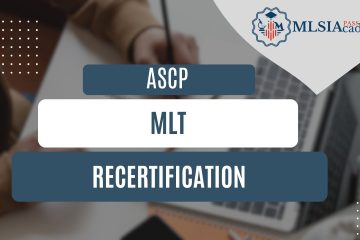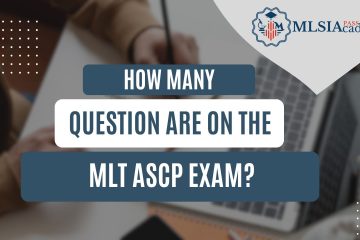MLT ASCP Reference Ranges: Do You Need to Learn Them?
Is getting knowledge about MLT ASCP reference ranges vital to pass the exam?
Yes, of course. They are a part of the syllabus. So, you cannot skip them.
What content do you need to encompass to pass the ASCP medical laboratory technician exam?
These include:
- Seven subjects, including chemistry, hematology, immunology, microbiology, blood bank, laboratory operation, and urine & other body fluids
- Calculations
- Reference ranges
In this blog post, you will know the entire exam syllabus, including MLT ASCP reference ranges.
MLT (ASCP) Exam Content Areas (Subjects): Subject & Main Topics
The following are all subjects and main topics for MLT ASCP certification exam preparation:
| Content Area | Main Topics |
| Blood banking | Blood products Physiology Blood group systems Transfusion practice Physiology Molecular/serologic testing Blood group immunology Pathophysiology. |
| Chemistry | Toxicology Nutrition Carbohydrates Enzymes Acid-base determination Protein Lipids Therapeutic drug monitoring Nitrogen-comprising compounds Heme derivatives Vitamins Endocrinology Electrolytes |
| Urine/Other Body Fluids | Disease conditions Chemical/physical experiments Physiology Microscopic testing. |
| Laboratory Operations | Automated/manual methods Troubleshooting Instruments Safety Lab rules and regulations |
| Hematology | Lab testing Transplantation Aliments states Physiology Serologic methods Hemostasis |
| Microbiology | Preanalytical/postanalytical techniques Analytical procedures for virology, mycobacteriology, mycology, parasitology. |
| Immunology | Immune system diseases Serologic methods Test consequences Infectious disease serology Transplantations. |
Calculations
- Manual hemocytometer counts
- Beer’s law
- Time urine calculations
- A/G ratios
- Red blood cell indices
- LDL/non-HDL/ Fridewald equation
- Creatinine clearance calculations
- % UIBC/Transferrin saturation/TIBC
- Indirected biprubin/Unconjugated
MLT ASCP Reference Ranges: Equally Important for Male and Female
MLT ASCP Reference Ranges: For Chemistry
| Conventional Units | SI Units | |
| Chloride | 98 – 107 mmol/L | 98 – 107 mmol/L |
| Sodium | 136 – 145 mmol/L | 136 – 145 mmol/L |
| Creatinine | 0.8 – 1.2 mg/dL | 71 – 106 µmol/L |
| Potassium | 3.5 – 5.1 mmol/L | 3.5 – 5.1 mmol/L |
| Total CO2 | 22 – 33 mmol/L | 22 – 33 mmol/L |
| Hemoglobin A1C | < 5.7% | < 39 mmol/mol |
| Glucose (fasting) | 74 – 100 mg/dL | 4.1 – 5.6 mmol/L |
| Blood urea nitrogen (BUN) | 6 – 20 mg/dL | 2.1 – 7.1 mmol/L |
| Haptoglobin | 30 – 200 mg/dL | 0.3 – 2.0 g/L |
| Arterial blood gases | ||
| pCO2 | 35 – 44 mmHg | 4.7 – 5.9 kPa |
| O2 saturation | > 95% | > 95% |
| pO2 | > 80 mmHg | > 10.6 kPa |
| HCO3– (bicarbonate) | 23 – 29 mmol/L | 23 – 29 mmol/L |
| pH | 7.35 – 7.45 | 7.35 – 7.45 |
MLT ASCP Reference Ranges: For Hematology
| Conventional Units | SI Units | |
| RBC | 4.00 – 6.00 x 106 /μL | 4.00 – 6.00 x 1012 /L |
| MCV | 76 – 100 fL | 76 – 100 fL |
| MCHC | 32 – 36 g/dL | 320 – 360 g/L |
| HGB | 12.0 – 18.0 g/dL | 120 – 180 g/L |
| HCT | 35% – 50% | 0.35 – 0.50 L/L |
| MCH | 26 – 34 pg | 26 – 34 pg |
| RDW | 11.5 – 14.5% | 0.115 – 0.145 |
| Reticulocytes (absolute) | 20 – 115 x 103 /μL | 20 – 115 x 09 /L |
| Reticulocytes (relative) | 0.5 – 2.5% | 0.005 – 0.025 |
| Platelets | 150 – 450 x 103 /μL | 150 – 450 x 109 /L |
| nRBCs | 0 nRBC/100 WBC | 0 nRBC/100 WBC |
| WBC (Total) | 3.6 – 10.6 x 103 /μL | 3.6 – 10.6 x 109/L |
| Lymphocytes (absolute) | 1.0 – 3.2 x 103 /μL | 1.0 – 3.2 x 109 /L |
| Lymphocytes (relative) | 18 – 42% | 0.18 – 0.42 |
| Basophils (absolute) | 0 – 0.2 x 103 /μL | 0 – 0.2 x 109 /L |
| Basophils (relative) | 0 – 2% | 0.00 – 0.02 |
MLT ASCP Reference Ranges: For Body Fluids
| Conventional Units | SI Units | |
| Cerebrospinal Fluids (CSF) | ||
| Glucose | 50 – 80 mg/dL | 2.8 – 4.4 mmol/L |
| WBC and RBC | 0 – 5/μL | 0 – 5 x 106 /L |
| Protein | 15 – 45 mg/dL | 150 – 450 mg/L |
| Urine | ||
| Leukocyte esterase | negative | negative |
| Protein | < 10 mg/dL, trace, or negative | < 10 mg/dL, trace, or negative |
| pH | 4.5 – 8.0 | 4.5 – 8.0 |
| Microscopic | ||
| WBC | 0 – 8/HPF | 0 – 8/HPF |
| RBC | 0 – 3/HPF | 0 – 3/HPF |
| Seminal Fluid | ||
| Volume | 2 – 5 mL | 2 – 5 mL |
| Sperm concentration | > 20 x 106 /mL | > 20 x 109 /L |
Some other MLT ASCP reference ranges you will see in the exam. These ranges may be given as needed in the exam by interrupting the above reference ranges.

Abdelhalim Elshawadfy is an ASCP certified Medical Laboratory Scientist (MLS ASCP), Specialist in Microbiology (SM ASCP), and Molecular Biology Technologist (MB ASCP) with a distinguished career marked by expertise, continuous learning, and a commitment to elevating the standards of clinical laboratory science. As an ASCP Certification Expert and American Board Certification Expert, Abdelhalim Elshawadfy continues to make invaluable contributions to the field, leaving a lasting impact on the medical community.



